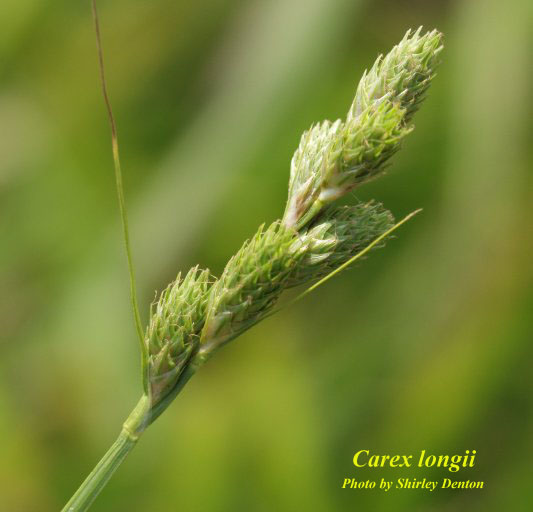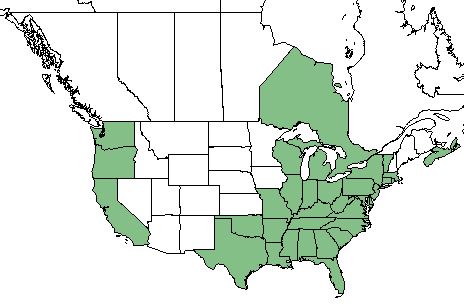Carex longii
Common names: Long's sedge [1] , Greenish-white Sedge [2]
| Carex longii | |
|---|---|

| |
| Photo by the Atlas of Florida Plants Database | |
| Scientific classification | |
| Kingdom: | Plantae |
| Division: | Magnoliophyta - Flowering plants |
| Class: | Liliopsida - Moncots |
| Order: | Cyperales |
| Family: | Cyperaceae |
| Genus: | Carex |
| Species: | C. longii |
| Binomial name | |
| Carex longii Mackenzie | |

| |
| Natural range of Carex longii from USDA NRCS Plants Database. | |
Contents
Taxonomic Notes
Synonyms: Carex albolutescens Schweinitz
Varieties: none
Description
C. longii is a perennial graminoid of the Cyperaceae family native to North America. [1]
Distribution
C. longii is native to the eastern United States and up into eastern Canada (Nova Scotia and Ontario), as well as the west coast of the United States. It is also native to Hawaii and Puerto Rico.[1]
Ecology
Habitat
It can commonly be found in bottomlands, bogs, and low fields.[3] C. longii has also been observed in roadside depressions, ditches, and other disturbed areas, drained ponds, marshes, pond banks, bottomland woodlands, and mixed hardwood swamps. Soils it can grow on include wet sandy loam, wet peaty sand, and dry sand.[4]
Associated species: Sphagnum sp., Juncus sp., Cyperus sp., Paspalum sp., Ptilimnium sp., Hydrocotyle sp., Rhynchospora sp., Osmunda sp., Rhexia mariana, Polygala lutea, Syngonanthus sp., Carex stipata, Carex fissa, Panicum sp., Ascyrum sp., Salix sp., Typha sp., Eryngium prostratum, Hypericum mutilum, Spartina sp., and Sagittaria lancifolia.[4]
Phenology
C. longii has been observed to flower from March to September with peak inflorescence between April and June. [5] Like other species in the Carex genus, it does not have a perianth.[6]
Conservation and Management
It is listed as endangered by the Ohio Department of Natural Resources.[1]
Cultivation and restoration
Photo Gallery
References and notes
- ↑ 1.0 1.1 1.2 1.3 USDA Plant Database Cite error: Invalid
<ref>tag; name "USDA" defined multiple times with different content - ↑ Orzell, S. L. and E. L. Bridges (2006). "Floristic composition of the south-central Florida dry prairie landscape." Florida Ecosystem 1(3): 123-133.
- ↑ Weakley, A. S. (2015). Flora of the Southern and Mid-Atlantic States. Chapel Hill, NC, University of North Carolina Herbarium.
- ↑ 4.0 4.1 Florida State University Robert K. Godfrey Herbarium database. URL: http://herbarium.bio.fsu.edu. Last accessed: March 2019. Collectors: Loran C. Anderson, Edwin L. Bridges, D. Burch, K. Craddock Burks, Richard Carter, Sharon Carter, Andre F. Clewell, Linda Wilson Curtis, R. J. Eaton, Robert K. Godfrey, Norlan C. Henderson, E. M. Hodgson, Richard D. Houk, Lisa Keppner, R. Kral, John M. Kunzer, H. Kurz, O. Lakela, Sidney McDaniel, Steve L. Orzell, James D. Ray, Jr., P. L. Redfearn, P. L. Redfearn, Jr., Grady W. Reinert, Cecil R. Slaughter, J. N. Triplett, Jr., Lovett E. Willimas, Jr., and Jean W. Wooten. States and Counties: Florida: Alachua, Bradford, Brevard, Citrus, Collier, Dixie, Flagler, Franklin, Gadsden, Hamilton, Hillsborough, Holmes, Jackson, Jefferson, Lake, Leon, Levy, Liberty, Madison, Marion, Nassau, Pasco, Pinellas, Seminole, St Johns, Suwannee, Taylor, Volusia, Wakulla, Walton, and Washington. Georgia: Brantley and Thomas.
- ↑ Nelson, G. PanFlora: Plant data for the eastern United States with emphasis on the Southeastern Coastal Plains, Florida, and the Florida Panhandle. www.gilnelson.com/PanFlora/ Accessed: 16 MAY 2018
- ↑ [[1]] Lady Bird Johnson Wildflower Center. Accessed: April 1, 2019